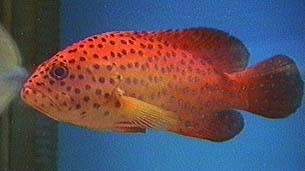If you enjoy a large aquarium with fewer but larger fish, often with distinctive personalities, Groupers may be just the fish for you! They are mostly solitary fish, prefering their own company, and they are predators!
Groupers are generally quite large fish when mature, but many of the juvenile forms are favorite aquarium specimens. Most groupers are hardy though there are a few that are more difficult to keep. Visit each fish for its particular needs.
They are a predatory fish and should therefore be feed meaty foods, such as live brine shrimp, squid, clams, and an occasional live goldfish. Feeding of freshwater feeders, such as goldfish, exclusively should be avoided since freshwater species lack certain nutrients required by the saltwater varieties.
For more Information on keeping marine fish see:
Guide to a Happy, Healthy Marine Aquarium








